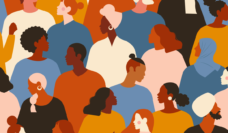The Covid-19 pandemic reflects our country’s racist systems that harm Black, Brown, and Indigenous communities. As early as March 2020, racial disparities in exposure and risk of severe illness or death due to Covid-19 were apparent. Black and Latinx people living in the United States are three times as likely to become infected with Covid-19 as white residents and almost twice as likely to die from the virus. In other words, about 21,200 Black, 10,000 Latinx, 1,000 Indigenous, and 70 Pacific Islander Americans would still be alive today had the rates of death in these communities been comparable to their white neighbors. Yet, Dr. Ibram X. Kendi and The Atlantic’s Covid-19 Tracking Project drew attention to the fact that many states were not initially reporting complete Covid-19 data by race. As a result of their advocacy, all states now report Covid-19 health metrics by some race categories.
Despite these advances in reporting race-specific data, substantial gaps in states’ reporting of Covid-19 health metrics remain for American Indian/Alaska Native (AI/AN) people. Just 18 states explicitly report AI/AN Covid-19 hospitalizations, and 36 states report AI/AN Covid-19 deaths (see figure), which our team tracks in the Covid-19 US State Policy (CUSP) database. These missing data lead to underestimates of the true burden of Covid-19 on Indigenous communities. This is particularly concerning considering available data across 23 states suggest that AI/AN are 3.5 times as likely as their white counterparts to be infected with Covid-19. A nationally representative estimate is likely to be even higher.
Accurate and timely state data reporting by race is critical for addressing and responding to the disparate burden of Covid-19. Many states omit AI/AN identities by clumping marginalized racial groups into the “other” category. Further, a high proportion of AI/AN deaths are systematically misclassified as white and it is difficult, if not impossible, to correct this error. Excluding AI/AN Covid-19 health metrics is particularly troubling in Texas, New York, and Florida, which hold the 4th, 7th, and 9th largest AI/AN populations, respectively.
Accurate and timely state data reporting by race is critical for addressing and responding to the disparate burden of Covid-19.
The ‘invisibilization’ of AI/AN populations in Covid-19 and other health data add insult to the injury of Indigenous genocide and structural racism sustained by white supremacy, inaccurate media portrayals/coverage, and lack of education about historical and contemporary Native peoples. This harm is perpetrated by federal and state agencies’ neglect to compile and provide accurate, meaningful, and timely data on AI/AN communities. It is crucial to explicitly address these structural harms in data collection and reporting in accordance with the Urban Indian Health Institute’s best practices. As AI/AN groups experience disproportionate harms, the lack of distinguishable data erases and abandons the populations’ true needs.
Although 35 states have at least one federally recognized tribe, over 71% of AI/AN populations live off tribal lands in metropolitan areas, demonstrating that all states have an obligation to report complete AI/AN data. The incoming federal administration has an opportunity to represent Indigenous peoples by implementing standards for racial data reporting on Covid-19 and all other indicators of health and well-being. Researchers, too, have a responsibility to engage with AI/AN communities and actively decolonize data by co-creating purposeful and empowering investigations.
The missing data also render the Covid-19 interventions within AI/AN communities invisible. Navajo Nation, which once experienced Covid-19 death and infection rates that rivaled New York City, mitigated community spread so effectively that, by September 8, they were able to report no new cases. The Lummi Nation was among the first in the United States to declare a state of emergency and implement mitigation strategies including early testing, stockpiling personal protective equipment, and social distancing measures. Although Covid-19 rates are again rising across the country, we can learn from the Navajo and Lummi People.
Photo via Getty Images

















